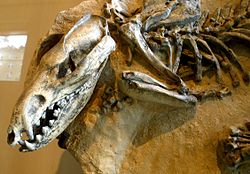- Metatheria
-
Metatheria Lycopsis longirostris, an extinct metathere from the Sparassodonta, a sister taxon to the marsupials Scientific classification Kingdom: Animalia Phylum: Chordata Class: Mammalia Subclass: Theria Infraclass: Metatheria
Thomas Henry Huxley, 1880Orders and infraclasses - †Alphadontia
- †Deltatheroida
- †Asiadelphia
- †Sparassodonta
- Marsupialia
- Didelphimorphia
- Paucituberculata
- Microbiotheria
- †Yalkaparidontia
- Dasyuromorphia
- Peramelemorphia
- Notoryctemorphia
- Diprotodontia
Metatheria is a grouping within the animal class Mammalia. First proposed by Thomas Henry Huxley in 1880, it is nearly synonymous with the earlier taxon Marsupialia (Illiger, 1811) though it is slightly wider since it also contains the nearest fossil relatives of marsupial mammals.
The earliest known representative, Sinodelphys, is from the Lower Cretaceous of China.[1]
The closest relatives of the metatheres are the Eutheria (also erected by Huxley in 1880). Both are conventionally united as infraclasses within the subclass Theria (Parker and Haswell, 1897), which contains all living mammals except monotremes.
During development, metatherians produce a yolk-sac placenta and give birth to "larval-like" offspring. These offspring have under-developed posterior limbs (the pes can be webbed), and following birth they migrate to the marsupium where they attach to a nipple. The mouth of newly-born metatherians is fused laterally, but open medially; this forms an "O" shaped mouth in which the mother's nipple fits; it then swells to secure the offspring into place for further development and growth.
The combination of the Greek elements meta- and theria in this usage roughly means the "sort-of-beasts" or " behind-beasts", in contrast with Eutheria ("true-beasts").
Evolutionary history
Metatherians first appeared in the Cretaceous Period, with such forms as Deltatheridium and Asiatherium. Some stem metatherians persisted well into the Neogene Period before becoming extinct. Examples of these include the borhyaenids and herpetotheriids. Crown marsupials, the one branch of Metatheria that survives today, diversified close to the time of extinction at the end of the Cretaceous.[2]
See also
References
- ^ Luo, Zhe-Xi; Ji, Qiang; Wible, John R.; Yuan, Chong-Xi (2003-12-12). "An early Cretaceous tribosphenic mammal and metatherian evolution". Science 302 (5652): 1934–1940. doi:10.1126/science.1090718. PMID 14671295. http://www.sciencemag.org/content/302/5652/1934.abstract. Retrieved 2010-12-27.
- ^ Horovitz, Inés; Martin, Thomas; Bloch, Jonathan; Ladevèze, Sandrine; Kurz, Cornelia; Sánchez-Villagra, Marcelo R.; Sánchez-Villagra, Marcelo R. (2009). "Cranial Anatomy of the Earliest Marsupials and the Origin of Opossums". PLoS ONE 4 (12): e8278. doi:10.1371/journal.pone.0008278. PMC 2789412. PMID 20016823. http://www.pubmedcentral.nih.gov/articlerender.fcgi?tool=pmcentrez&artid=2789412.
- McKenna MC & Bell SK, (1997), Classification of Mammals Above the Species Level. Columbia University Press.
Extant mammal orders by infraclass Australosphenida Metatheria
(Marsupial inclusive)Eutheria
(Placental inclusive)
This article about a mammal is a stub. You can help Wikipedia by expanding it.

